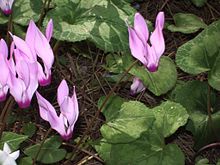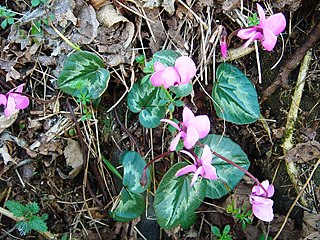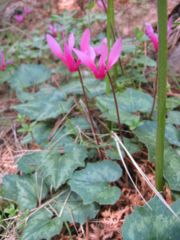Cyclamen
| Cyclamen | |
|---|---|

| |
| Wild Cyclamen persicum | |
| Scientific classification | |
| Kingdom: | Plantae |
| Clade: | Tracheophytes |
| Clade: | Angiosperms |
| Clade: | Eudicots |
| Clade: | Asterids |
| Order: | Ericales |
| Family: | Primulaceae |
| Subfamily: | Myrsinoideae |
| Genus: | Cyclamen L. |
| Species | |
| Synonyms[1] | |
| |

Cyclamen (US: /ˈsaɪkləmən/ SY-klə-mən or UK: /ˈsɪkləmən/ SIK-lə-mən)[2][3][4] is a genus of 23 species of perennial flowering plants in the family Primulaceae. In English, it is known by the common names sowbread or swinebread. Cyclamen species are native to Europe and the Mediterranean Basin east to the Caucasus and Iran, with one species in Somalia. They grow from tubers and are valued for their flowers with upswept petals and variably patterned leaves.
It was traditionally classified in the family Primulaceae, was reclassified in the family Myrsinaceae[5] in 2000[6] and finally, in 2009 with the introduction of the APG III system, was returned to the subfamily Myrsinoideae within the family Primulaceae.[7]
Names
[edit]Cyclamen is Medieval Latin, from earlier Latin cyclamīnos,[8] from Ancient Greek κυκλάμινος, kyklā́mīnos (also kyklāmī́s), from κύκλος, kýklos "circle",[9] because of the round tuber.[10] In English the species of the genus are commonly called by the genus name.
Pliny the Elder describes how it was called in antiquity by Roman country men: tūber terrae, literally "earth truffle" or also amulētum "amulet", because it was believed that evil spells had no effect where it grew.[11]
In many languages cyclamen species are colloquially called by a name like the English sowbread or swinebread (because they are said to be eaten by pigs), based on Medieval Latin panis porcinus: Saubrot in German, pain de pourceau in French, pan porcino in Italian and varkensbrood in Dutch.
Description
[edit]Cyclamen have a tuber, from which the leaves, flowers and roots grow. In most species leaves come up in autumn, grow through the winter and then die in spring, then the plant goes dormant through the dry Mediterranean summer.
Tuber
[edit]

The storage organ of the cyclamen is a round tuber, which develops from the hypocotyl (the stem of a seedling). It is often mistakenly called a corm, but a corm (found in crocuses, for example) has a papery tunic and a basal plate from which the roots grow. The storage organ of the cyclamen has no papery covering and, depending on the species, roots may grow out of any part. It is therefore properly classified as a tuber (somewhat like a potato). The tuber may produce roots from the top, sides or bottom, depending on the species. Cyclamen persicum and Cyclamen coum root from the bottom; Cyclamen hederifolium roots from the top and sides. Cyclamen graecum has thick anchor roots on the bottom.[12] The roots and tubes of cyclamen plants are known to contain the compound cyclamin.
The shape of the tuber may be near spherical, as in Cyclamen coum, or flattened, as in Cyclamen hederifolium. In some older specimens of Cyclamen purpurascens and Cyclamen rohlfsianum growing points on the tuber become separated by shoulders of tissue and the tuber becomes misshapen.[13] In most other species the tuber is round in old age.
Leaves and flowers sprout from growing points on the top of the tuber. Growing points that have lengthened and become like woody stems are known as floral trunks.[13]
The size of the tuber varies depending on species. In Cyclamen hederifolium older tubers commonly reach 24 cm (9+1⁄2 in) across, but in Cyclamen parviflorum tubers do not grow larger than 2 cm (3⁄4 in) across.[13]
Leaves
[edit]Leaves sprout from growing points or floral trunks on top of the tuber. Each leaf grows on its own stem.[14] Leaf stems in early growth may be distinguished from flower stems by the direction their tips curl: tips of leaf stems curl upwards and those of flower stems curl downwards.
The shape of the leaves varies among the species and even among different specimens of the same species. Cyclamen hederifolium and Cyclamen repandum usually have leaves shaped like ivy, with angles and lobes, Cyclamen coum has nearly round leaves and Cyclamen persicum has heart-shaped leaves with a pointed tip. The leaf margin may be smooth, as in Cyclamen coum subsp. coum, or finely toothed, as in Cyclamen graecum.[14]
The color of the upper side of leaves is variable, even within a species. Most species have leaves variegated in several shades of green and silver, either in an irregular pattern of blotches or an arrowhead or Christmas-tree shape. In cultivation cyclamen, especially species other than Cyclamen persicum, are selected as often for striking or unusual leaf patterns as for their flowers.[14]
The lower side of leaves is often shiny and its color varies from plain green to rich red or purple.[14]
Most cyclamen species originate from the Mediterranean, where summers are hot and dry and winters are cool and wet, and are summer-dormant: their leaves sprout in the autumn, remain through the winter and wither the next spring. Cyclamen purpurascens and Cyclamen colchicum, however, originate from cooler regions in mountains and their leaves remain through the summer and wither only after the next year's leaves have developed.
Flowers
[edit]
Flowering time may be any month of the year, depending on the species. Cyclamen hederifolium and Cyclamen purpurascens bloom in summer and autumn, Cyclamen persicum and Cyclamen coum bloom in winter and Cyclamen repandum blooms in spring.[15]
Each flower is on a stem coming from a growing point on the tuber.[15] In all species the stem is normally bent 150-180° at the tip so that the nose of the flower faces downwards. Cyclamen hederifolium 'Stargazer' is an exception: its nose faces upwards. Flowers have 5 petals, bent outwards or up, sometimes twisted, and connected at the base into a cup, and five sepals behind the cup.
Petal shape varies depending on species and sometimes within the same species. Cyclamen repandum has petals much longer than wide, Cyclamen coum has stubby, almost round petals, and Cyclamen hederifolium usually has petals with proportions between the two.
Petal color may be white, pink or purple, often with darker color on the nose. Many species have a pink form and a white form but a few have only one color, such as Cyclamen balearicum, which is always white.
The dark color on the flower nose varies in shape: Cyclamen persicum has a smooth band, Cyclamen hederifolium has a streaky V and Cyclamen coum has an M-shaped splotch with two white or pink ‘eyes’ beneath.
In some species, such as Cyclamen hederifolium, the petal edges at the nose are curved outwards into auricles (Latin for ‘little ears’). Most species, such as Cyclamen persicum, have no auricles.
In most species the style protrudes 1–3 mm out of the nose of the flower but the stamens are inside the flower. In Cyclamen rohlfsianum, however, the cone of anthers sticks out prominently, about 2–3 mm (0.08–0.12 in) beyond the rim of the corolla, similar to shooting-stars (Primula sect. Dodecatheon).
Fruit
[edit]The flower stem coils or bends when the fruit begins to form. The stems of Cyclamen hederifolium and Cyclamen coum coil starting at the end, Cyclamen persicum arches downwards but does not curl, Cyclamen rohlfsianum coils start near the tuber and Cyclamen graecum coils in both directions, starting in the middle.
The fruit is a round pod, which opens by several flaps or teeth at maturity and contains numerous sticky seeds, brown at maturity. Natural seed dispersal is by ants (myrmecochory), which eat the sticky covering and then discard the seeds.
Taxonomy
[edit]The genus Cyclamen was first described by Carl Linnaeus in Species Plantarum in 1753.[16]
Phylogeny
[edit]A phylogeny of Cyclamen published in 2000, with four supported clades approximately corresponding to four subgenera, is shown below.[17] The phylogeny is based on morphology, cytology and DNA-sequences. A few species that were not included in the analysis are placed based on morphology only and are noted with a question mark.
| genus Cyclamen |
| ||||||||||||
A study published in 2004 produced a similar phylogeny in a combined analysis of molecular and morphological data:[18]
| |||||||||||||||||||||||||||||||||||||||||||||||||||||||||||||||||||||||||||||||||||||||||||||||||||||||||||||||||||||||||
A comparison of the groups produced in the two studies shows them to be very similar (see the table below). Nevertheless, the authors of the 2004 study declined to produce a subgeneric classification, concluding that more work was needed to align the phylogeny and classification of Cyclamen, stating that "the publication of formal classifications before adequate data can provide a clear and consistent pattern of information, leads to nomenclatural instability".[18]
| Anderberg et al. (2000)[17] | Compton et al. (2004)[18] |
|---|---|
Subgenus Psilanthum
|
Clade A
|
Subgenus Cyclamen
|
Clade B
|
Subgenus Eucosme
|
Clade C
|
Subgenus Gyrophoebe
|
Clade D
|
Species
[edit]As of May 2021[update], Plants of the World Online accepted the following species:
- Cyclamen africanum Boiss. & Reut.
- Cyclamen alpinum Dammann ex Sprenger
- Cyclamen balearicum Willk.
- Cyclamen cilicium Boiss. & Heldr.
- Cyclamen colchicum (Albov) Correvon
- Cyclamen coum Mill.
- Cyclamen creticum (Dörfl.) Hildebr.
- Cyclamen cyprium Kotschy
- Cyclamen graecum Link
- Cyclamen hederifolium Aiton
- Cyclamen intaminatum (Meikle) Grey-Wilson
- Cyclamen libanoticum Hildebr.
- Cyclamen mirabile Hildebr.
- Cyclamen parviflorum Pobed.
- Cyclamen persicum Mill.
- Cyclamen pseudibericum Hildebr.
- Cyclamen purpurascens Mill.
- Cyclamen repandum Sm.
- Cyclamen rohlfsianum Asch.
- Cyclamen somalense Thulin & Warfa
Ecology
[edit]Cyclamen species are eaten by the caterpillars of the gothic moth.
Conservation
[edit]Cyclamen diversity in the Mediterranean has been studied extensively to understand how the species remain distinct (Debussche et al., 2000, 2002, 2003) and how they have reacted to the dramatic climate changes in the region. Certain climate-change models suggest many species could become extinct in their current range within the next 50 years.[19]
In many areas within the native range cyclamen populations have been severely depleted by collection from the wild, often illegally, for the horticultural trade; some species are now endangered as a result. However in a few areas plant-conservation charities have educated local people to control the harvest carefully at a sustainable level, including sowing seed for future crops, both sustaining the wild populations and producing a reliable long-term income. Many cyclamen are also propagated in nurseries without harm to the wild plants.
Culture
[edit]In the sixteenth century, women in their early stages of pregnancy avoided cyclamens in fear of a miscarriage because they were considered to strongly induce childbirth.[20]
Cyclamens were used as love-charms, aphrodisiacs, and intoxicant and a small amount would be put in cakes or a cup of wine.[20]
Cultivation and uses
[edit]
Cyclamen are commonly grown for their flowers, both outdoors and indoors in pots. Several species, particularly Cyclamen hederifolium, are hardy and can be grown outdoors in mild climates such as northwest Europe and the Pacific Northwest of North America.
The Cyclamen Society is the International Cultivar Registration Authority for Cyclamen excluding C. persicum, and currently recognises over 100 registered cultivars.[21]
Hardiness
[edit]Cyclamen species range from frost-hardy to frost-tender.
The most frost-hardy species, such as C. purpurascens, C. hederifolium, C. coum and C. cilicium, tolerate temperatures down to −20 °C (−4 °F). C. hederifolium has even survived prolonged freezing and temperatures down to −30 °C (−22 °F). C. repandum survives temperatures down to −14 °C (7 °F) but not prolonged freezing below this temperature. C. graecum tolerates frost as low as −4 °C (25 °F) for a few hours. Others, such as C. africanum, C. persicum and C. rohlfsianum, tolerate only mild and brief frost.
Florists’ cyclamen
[edit]The cyclamen commonly sold by florists is Cyclamen persicum, which is frost-tender. Selected cyclamen cultivars have white, bright pink, red or purple flowers. While flowering florists' cyclamen should be kept below 20 °C (68 °F), with the night-time temperatures preferably 6.5–15 °C (43.7–59.0 °F). Temperatures above 20 °C (68 °F) may induce the plant to become dormant.
Gallery
[edit]Cyclamen bloom in different seasons, depending on the species.
- Winter and spring
-
C. alpinum
-
C. balearicum
-
C. coum
-
C. coum subsp. caucasicum
-
C. coum subsp. elegans, syn. C. elegans
-
C. creticum
-
C. libanoticum
-
C. parviflorum
-
C. persicum
-
C. pseudibericum
-
C. repandum
-
C. repandum subsp. rhodense, syn. C. rhodium
- Summer and autumn
-
C. africanum
-
C. cilicium
-
C. colchicum
-
C. cyprium
-
C. graecum
-
C. intaminatum
-
C. hederifolium
-
C. mirabile
-
C. purpurascens
-
C. rohlfsianum
References
[edit]Notes
[edit]- ^ Cyclamen L. | Kew Science. (n.d.). Plants of the World Online. Retrieved December 5, 2022, from https://powo.science.kew.org/taxon/urn:lsid:ipni.org:names:32774-1
- ^ cyclamen (noun). Oxford Advanced Learner's Dictionary. Oxford University Press. 2014.
- ^ "cyclamen". Oxford English Dictionary (Online ed.). Oxford University Press. (Subscription or participating institution membership required.)
- ^ "cyclamen". Merriam-Webster.com Dictionary. Merriam-Webster.
- ^ "Cyclamen". Encyclopedia Britannica. Retrieved 2019-12-18.
- ^ Källersjö, Bergqvist & Anderberg 2000
- ^ Stevens 2012
- ^ cyclamīnos. Charlton T. Lewis and Charles Short. A Latin Dictionary on Perseus Project.
- ^ κυκλάμινος, κύκλος. Liddell, Henry George; Scott, Robert; A Greek–English Lexicon at the Perseus Project
- ^ Harper, Douglas. "cyclamen". Online Etymology Dictionary.
- ^ Pliny the Elder; Rackham, H. (Harris) (1938). Natural history. OISE - University of Toronto. London : W. Heinemann. pp. BOOK XXV, LXVII.
- ^ Grey-Wilson 2002, p. 35.
- ^ a b c Grey-Wilson 2002, p. 34.
- ^ a b c d Grey-Wilson 2002, p. 36.
- ^ a b Grey-Wilson 2002, p. 37.
- ^ "Cyclamen L." The International Plant Names Index. Retrieved 2021-05-08.
- ^ a b Anderberg, Trift & Källersjö 2000
- ^ a b c Compton, Clennett & Culham 2004
- ^ Yesson & Culham 2006
- ^ a b Radford, Edwin (1961). Encyclopaedia of superstitions. Christina Hole, M. A. Radford (Revised and enlarged edition by Christina Hole ed.). London. ISBN 0-09-125200-8. OCLC 840105.
{{cite book}}: CS1 maint: location missing publisher (link) - ^ "Cultivar List". The Cyclamen Society. Retrieved 12 October 2023.
Sources
[edit]- Anderberg, Arne A.; Trift, Ida; Källersjö, Mari (2000). "Phylogeny of Cyclamen L. (Primulaceae): Evidence from morphology and sequence data from the internal transcribed spacers of nuclear ribosomal DNA". Plant Systematics and Evolution. 220 (3–4): 147–160. Bibcode:2000PSyEv.220..147A. doi:10.1007/BF00985043. S2CID 12464092.
- Compton, James A.; Clennett, J. Chris B. & Culham, Alastair (2004). "Nomenclature in the dock. Overclassification leads to instability: a case study in the horticulturally important genus Cyclamen (Myrsinaceae)". Botanical Journal of the Linnean Society. 146 (3): 339–349. doi:10.1111/j.1095-8339.2004.00322.x.
- Debussche, Max; Debussche, Geneviève; Grandjanny, Michel (2000). "Distribution of Cyclamen repandum Sibth. & Sm. subsp. repandum and ecology in Corsica and continental France". Acta Botanica Gallica. 147 (2): 123–142. doi:10.1080/12538078.2000.10515404.
- Debussche, Max; Thompson, John D (2002). "Morphological differentiation among closely related species with disjunct distributions: a case study of Mediterranean Cyclamen L. subgen. Psilanthum Schwarz (Primulaceae)". Botanical Journal of the Linnean Society. 139 (2): 133–144. doi:10.1046/j.1095-8339.2002.00054.x.
- Debussche, Max; Thompson, John D (2003). "Habitat differentiation between two closely related Mediterranean plant species, the endemic Cyclamen balearicum and the widespread C. repandum". Acta Oecologica-International Journal of Ecology. 24 (1): 35–45. Bibcode:2003AcO....24...35D. doi:10.1016/s1146-609x(02)00006-1.
- Grey-Wilson, Christopher (1998). Cyclamen: a guide for gardeners, horticulturists, and botanists. Timber Press.
- Grey-Wilson, Christopher (2002). Cyclamen: a guide for gardeners, horticulturists, and botanists (revised and updated ed.). Timber Press.
- Källersjö, Mari; Bergqvist, Gullevi; Anderberg, Arne A. (2000). "Generic realignment in primuloid families of the Ericales s.l.: A phylogenetic analysis based on DNA sequences from three chloroplast genes and morphology". American Journal of Botany. 87 (9): 1325–1341. doi:10.2307/2656725. JSTOR 2656725. PMID 10991903.
- Stevens, Peter F (July 2012). "Myrsinoideae". Angiosperm Phylogeny Website.
- Thulin, Mats; Warfa, Ahmed Mumin (1989). "Cyclamen (Primulaceae) in tropical Africa". Plant Systematics and Evolution. 166 (3–4): 249–252. Bibcode:1989PSyEv.166..249T. doi:10.1007/bf00935953. S2CID 28587660.
- Yesson, Chris; Culham, Alastair (2006). "A phyloclimatic study of Cyclamen". BMC Evolutionary Biology. 6 (72): 72. doi:10.1186/1471-2148-6-72. PMC 1599755. PMID 16987413.
- Yesson, C; Toomey, NH; Culham, A (2008). "Cyclamen: Time, sea and speciation biogeography using a temporally calibrated phylogeny". Journal of Biogeography. 36 (7): 1234–1252. doi:10.1111/j.1365-2699.2008.01971.x. S2CID 85573501.


























